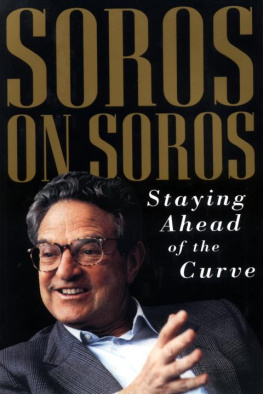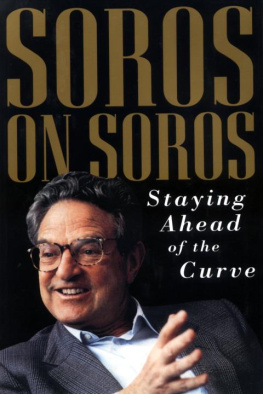The New Paradigm for Financial Markets
ALSO BY GEORGE SOROS
The Age of Fallibility: The Consequences of the War on Terror
The Bubble of American Supremacy: The Cost of Bush's War in Iraq
George Soros on Globalization
Open Society: Reforming Global Capitalism
The Crisis of Global Capitalism: Open Society Endangered
Soros on Soros: Staying Ahead of the Curve
Underwriting Democracy
Opening the Soviet System
The Alchemy of Finance: Reading the Mind of the Market
The New Paradigm for Financial Markets
THE CREDIT CRISIS OF 2008 AND WHAT IT MEANS
GEORGE SOROS

Copyright 2008 by George Soros.
Published in the United States by PublicAffairs,
a member of the Perseus Books Group.
All rights reserved.
Printed in the United States of America.
No part of this book may be reproduced in any manner whatsoever without written permission except in the case of brief quotations embodied in critical articles and reviews. For information, address PublicAffairs, 250 West 57th Street, Suite 1321, New York, NY 10107. PublicAffairs books are available at special discounts for bulk purchases in the U.S. by corporations, institutions, and other organizations. For more information, please contact the Special Markets Department at the Perseus Books Group, 2300 Chestnut Street, Suite 200, Philadelphia, PA 19103, call (800) 810-4145, x5000, or email special.markets@perseusbooks.com.
TEXT SET IN JANSON TEXT
Cataloging-in-Publication Data is available from the Library of Congress.
ISBN 978-1-58648-683-9 (hardback)
ISBN 978-1-58648-684-6 (e-book)
FIRST EDITION
1 3 5 7 9 10 8 6 4 2
Contents
Part Two:
The Current Crisis and Beyond
Introduction
We are in the midst of the worst financial crisis since the 1930s. In some ways it resembles other crises that have occurred in the last twenty-five years, but there is a profound difference: the current crisis marks the end of an era of credit expansion based on the dollar as the international reserve currency. The periodic crises were part of a larger boom-bust process; the current crisis is the culmination of a super-boom that has lasted for more than twenty-five years.
To understand what is going on we need a new paradigm. The currently prevailing paradigm, namely that financial markets tend towards equilibrium, is both false and misleading; our current troubles can be largely attributed to the fact that the international financial system has been developed on the basis of that paradigm.
The new paradigm I am proposing is not confined to the financial markets. It deals with the relationship between thinking and reality, and it claims that misconceptions and misinterpretations play a major role in shaping the course of history. I started developing this conceptual framework as a student at the London School of Economics before I became active in the financial markets. As I have written before, I was greatly influenced by the philosophy of Karl Popper, and this made me question the assumptions on which the theory of perfect competition is based, in particular the assumption of perfect knowledge. I came to realize that market participants cannot base their decisions on knowledge alone, and their biased perceptions have ways of influencing not only market prices but also the fundamentals that those prices are supposed to reflect. I argued that the participants' thinking plays a dual function. On the one hand, they seek to understand their situation. I called this the cognitive function. On the other hand, they try to change the situation. I called this the participating or manipulative function. The two functions work in opposite directions and, under certain circumstances, they can interfere with each other. I called this interference reflexivity.
When I became a market participant, I applied my conceptual framework to the financial markets. It allowed me to gain a better understanding of initially self-reinforcing but eventually self-defeating boom-bust processes, and I put that insight to good use as the manager of a hedge fund. I expounded the theory of reflexivity in my first book, The Alchemy of Finance, which was published in 1987. The book acquired a cult following, but the theory of reflexivity was not taken seriously in academic circles. I myself harbored grave doubts about whether I was saying something new and significant. After all, I was dealing with one of the most basic and most thoroughly studied problems of philosophy, and everything that could be said on the subject had probably already been said. Nevertheless, my conceptual framework remained something very important for me personally. It guided me both in making money as a hedge fund manager and in spending it as a philanthropist, and it became an integral part of my identity.
When the financial crisis erupted, I had retired from actively managing my fund, having previously changed its status from an aggressive hedge fund to a more sedate endowment fund. The crisis forced me, however, to refocus my attention on the financial markets, and I became more actively engaged in making investment decisions. Then, towards the end of 2007, I decided to write a book analyzing and explaining the current situation. I was motivated by three considerations. First, a new paradigm was urgently needed for a better understanding of what is going on. Second, engaging in a serious study could help me in my investment decisions. Third, by providing a timely insight into the financial markets, I would ensure that the theory of reflexivity would finally receive serious consideration. It is difficult to gain attention for an abstract theory, but people are intensely interested in the financial markets, especially when they are in turmoil. I have already used the financial markets as a laboratory for testing the theory of reflexivity in The Alchemy of Finance; the current situation provides an excellent opportunity to demonstrate its relevance and importance. Of the three considerations, the third weighed most heavily in my decision to publish this book.
The fact that I had more than one objective in writing it makes the book more complicated than it would be if it were focused solely on the unfolding financial crisis. Let me explain briefly how the theory of reflexivity applies to the crisis. Contrary to classical economic theory, which assumes perfect knowledge, neither market participants nor the monetary and fiscal authorities can base their decisions purely on knowledge. Their misjudgments and misconceptions affect market prices, and, more importantly, market prices affect the so-called fundamentals that they are supposed to reflect. Market prices do not deviate from a theoretical equilibrium in a random manner, as the current paradigm holds. Participants' and regulators' views never correspond to the actual state of affairs; that is to say, markets never reach the equilibrium postulated by economic theory. There is a two-way reflexive connection between perception and reality which can give rise to initially self-reinforcing but eventually self-defeating boom-bust processes, or bubbles. Every bubble consists of a trend and a misconception that interact in a reflexive manner. There has been a bubble in the U.S. housing market, but the current crisis is not merely the bursting of the housing bubble. It is bigger than the periodic financial crises we have experienced in our lifetime. All those crises are part of what I call a super-bubblea long-term reflexive process which has evolved over the last twenty-five years or so. It consists of a prevailing trend, credit expansion, and a prevailing misconception, market fundamentalism (aka
Next page






